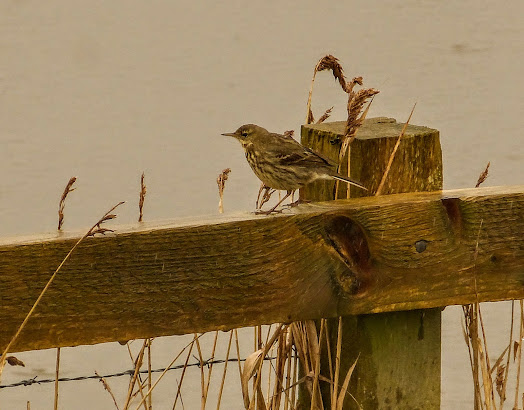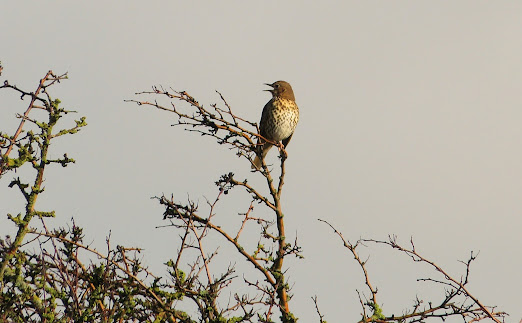Saturday 24th February 2024.
It was just Geoff Farwell and myself that went birding this morning as our Andy had car troubles and had to stay behind to sort that out. When I left my home this morning, it was clearly evident that there was a heavy frost overnight, so I didn't expect some heavy rain showers when we arrived at our destination this morning. Driving through the New Forest towards Lymington, the heavens really opened and judging by the heavy clouds overhead, it did not bode well for a dry morning's birding. We arrived at the small car park at Pennington Marshes around 9am and thankfully, the rain had stopped for a while.
I thought I would go to Pennington Marshes today to catch up with some of the birds I missed when I went up to Norfolk (which now seems like an age ago!).Though I knew the Red-breasted Goose had seemed to have left the area, it didn't stop me checking the many Brent Geese that were still present here, just in case. Today, I picked up 6 more Hampshire ‘year-ticks’ here this morning, with three of them new for the year on my overall total for the year. But it's not all about year ticks, for the birds here most certainly entertained and the variety was superb. As always, Geoff is great company as we made our way to the seawall, enjoying views of passing wildfowl and a few waders overhead.
From the sea wall, we headed west first to the lagoons that held good numbers of both waders and wildfowl. A superb male Marsh Harrier drifted east in front of us and headed off over the marshes, scattering a few ducks on the way. The tide was up within the Solent and the sea was very still, which helped pick off any Grebes on the water. At least four Great Crested Grebes were seen and a distant Shag, but I was more than happy when I found our first Slavonian Grebe of the day (my first ‘year-tick’) ; a solitary bird near the fresh marsh. More were to follow later in the afternoon. Among the many Tufted Duck and Shovelers, the long staying male Scaup was present on Fishtail Lagoon and showed very well as it busied itself diving in the shallow water (see film footage). A good number of waders were mixed in with some of the resting wildfowl on the islands, for all the pools were virtually flooded due to high water levels. I found my first ‘Hampshire’ Ruff with Redshank and at least two more were picked out along with good numbers of both Dunlin and Bar-tailed Godwit. Even the main footpath along the sea wall held small numbers of Turnstone that were more than happy searching for food close to where we stood!
I checked the Solent thoroughly for anything of note, including the many Brent Geese dabbling around by the Saltmarsh and then I picked out a female Peregrine flying away from us heading west. Also looking west, a distant Great White Egret was sleeping on the edge of Keyhaven Lagoon along with a few Little Egrets. Annoyingly, another huge rain shower came in and so we slowly made our way along the seawall and headed east towards Oxey Marsh. By the edge of the seawall, there were a good few Rock Pipits around and a small flock of three birds also held a male Reed Bunting (several heard singing this morning too) and a pair of Pied Wagtails.
Nearing Oxey Marshes, something caught my eye out in the Solent and so setting up my scope, it turned out to be a pair of Red-breasted Mergansers. Scanning further east towards the small islands off Normandy Marshes, I found a flock of 15 resting Eiders; mostly drakes and a few females and quickly got Geoff onto the birds. These were my first ‘Hampshire’ birds after seeing one a few weeks ago in Holkham Bay, Norfolk. Sadly, too distant to get a decent photo of these smart birds. As we neared the point by Oxey Marshes, the long staying Spotted Redshank made an appearance (again, my first ‘Hampshire’ bird of the year). The bird was busy feeding and put on a wonderful performance just below us on the main pool (see film footage). There were plenty of Redshanks around the area and then Geoff found a Greenshank that also performed well in front of us along with a lone Avocet.
As we passed the creek by Oxey Marshes and followed the footpath to Normandy Marshes where the Spoonbills were seen earlier today, Geoff found an Egyptian Goose among the many Canada Geese on one of the pools (another first for Hampshire this year!). There were plenty of people walking dogs (a lot were unfortunately off their leads), ramblers and Cyclists along the seawall and believe it or not, several birders too! We eventually got to Normandy Marshes and as Geoff said, arguably the best pool we had come to this morning. The 11 Spoonbills showed very well, but remained in a resting flock on one of the islands along with at least 30+ Avocet and good numbers of Dunlin and Ringed Plover.There was a good variety of birds here as I enjoyed my flask of coffee and checked out the birds before us through my scope.
Wildfowl here included Pintail, Shoveler, Tufted Duck, Teal, Wigeon and Mallard, with smaller numbers of Pochard (they seem to be scarce away from Blashford Lakes this year), three Red-breasted Mergansers (a drake and two females) and a lone gorgeous drake Goldeneye. There were plenty of waders present as mentioned earlier, but no Little Stints among the many Dunlin present despite a good search. Several Great Crested Grebes also swam in the pool and a few Little Grebes too to add a bit more variety here. So, after around an hour here, we made our way back to the car. Walking around the seawall past Oxey Marshes, we came across at least two Slavonians Grebes close in on the Solent. These birds were a lot closer than our first sighting earlier this morning and showed very well with a few Great Crested Grebes present.
It was 2.30pm when we finally got back to the car park and I wanted to finish the day off with either South Boarhunt for the Little Owls or Farlington Marshes for a possible Bittern. There have been a few Bittern sightings at dusk at the latter site this week and so I made the decision to try my luck there, even though it was hammering down with rain on the way back. We sat in the car within the car park on arrival, waiting for the rain to stop and when it eventually did, it was then a glorious late afternoon right up to dusk. As we walked past the Bushes area, a Song Thrush was in full song on top of a bramble and I caught sight of a Green Woodpecker briefly flying away from us.
We made our way to the viewpoint that looks west over the site and was a little dismayed at how high the water level was on the main lake. Was the Sluice here actually working properly for it certainly doesn't look like it! The tide was now out within the harbour, but the creek here held good numbers of waders and wildfowl, that included several Avocets in the distance. The light now was perfect as I scanned the fields for anything of note. A good scan through the hundreds of Brent Geese in the fields didn't reveal a Red-breasted Goose hiding among them, but I did find a Pale-bellied Brent Goose among them. Raptors were prominent on the reserve that included a pair of Marsh Harriers quartering the main reedbed, which occasionally tussled with the local Buzzards here. A pair of Sparrowhawks were also seen hunting over the reserve along with at least two Kestrels, but there was no sign of any Short-eared Owls during our stay here right up till dusk. A male Stonechat was on a fence post behind the main reedbed, with one of the Common Buzzards looking towards it. Supper? As mentioned before, the light was amazing as the sun slowly set behind us, but sadly, despite watching the main reedbed for any Bitterns, none appeared during our stay. Never mind, for it was really enjoyable being here watching the birds coming into roost. The light was so good that I could see Skylarks running about in the fields through my scope and even a perched Marsh Harrier on a post that was partially hidden by the reeds; things to look back on in the future. It’s little things like that which makes our hobby so fantastic.


































No comments:
Post a Comment